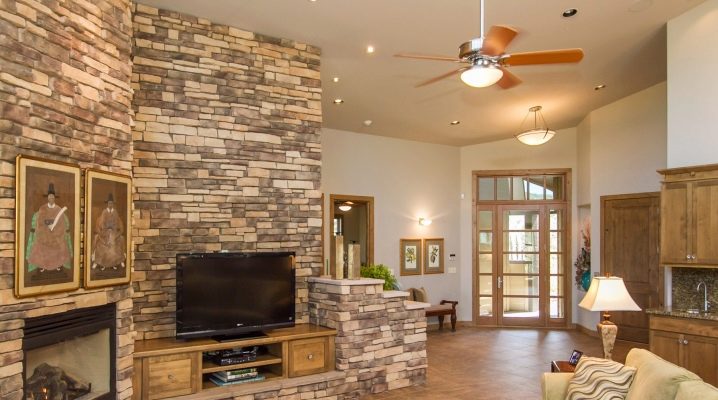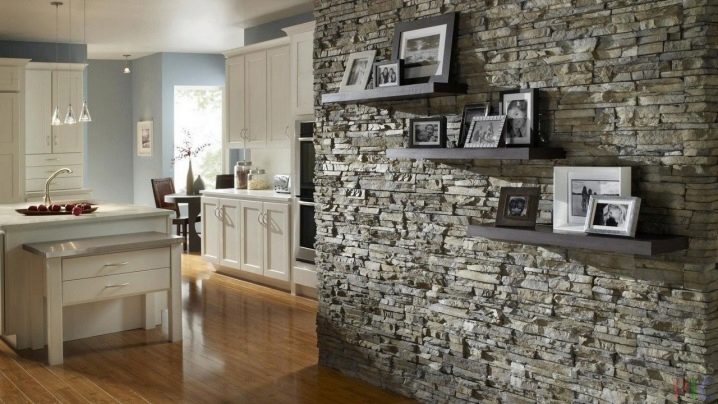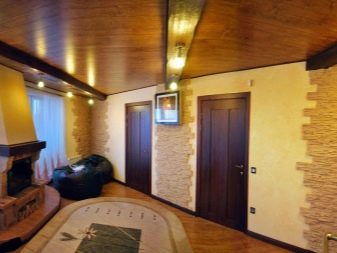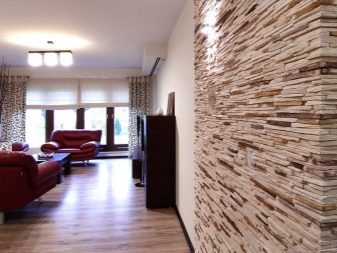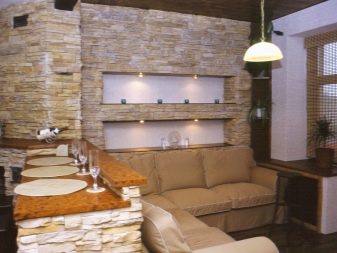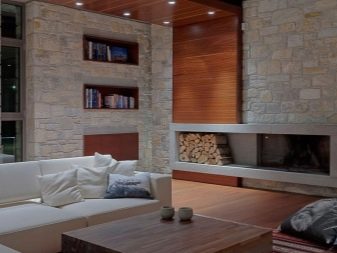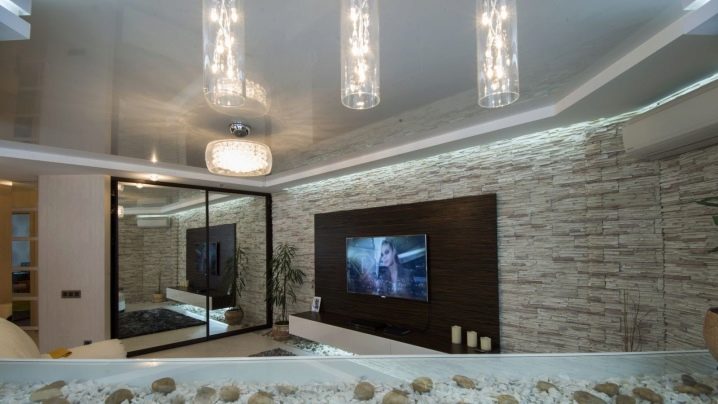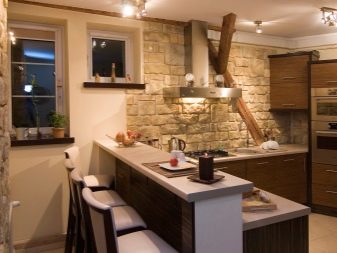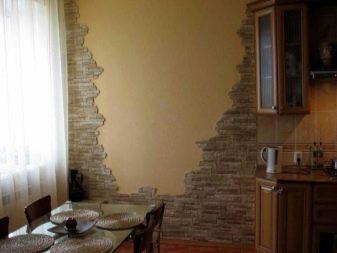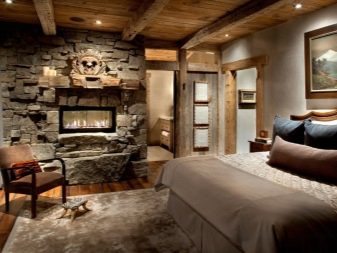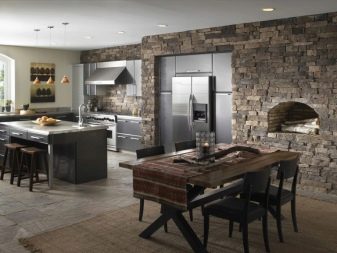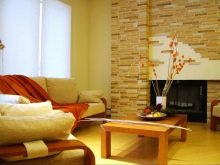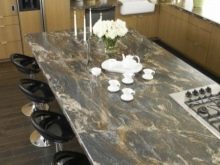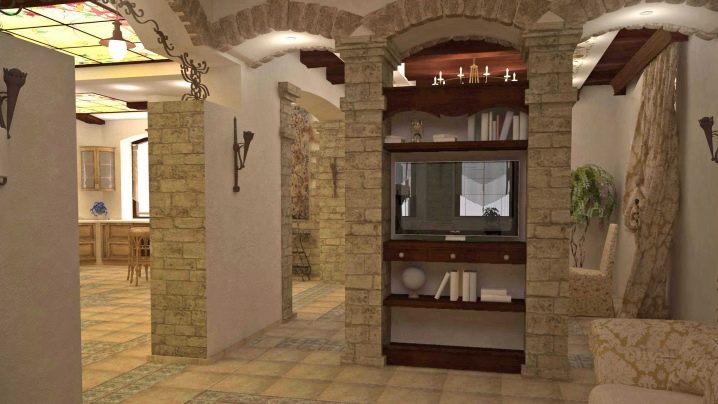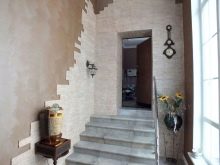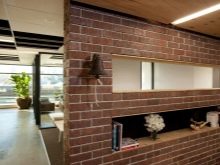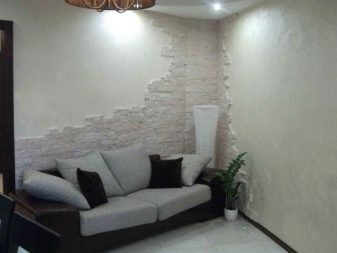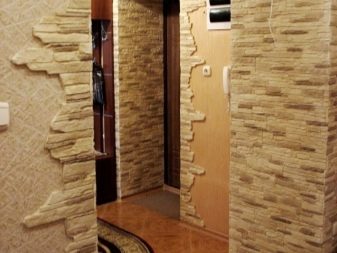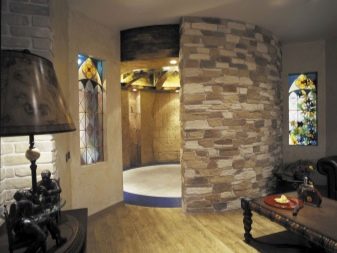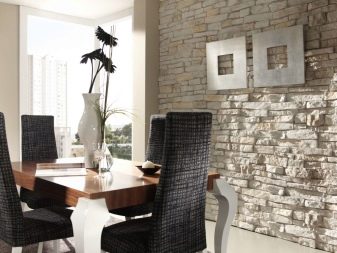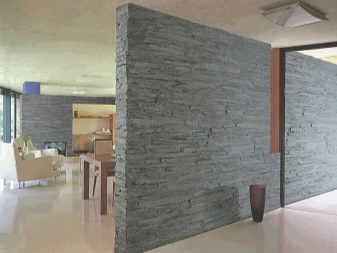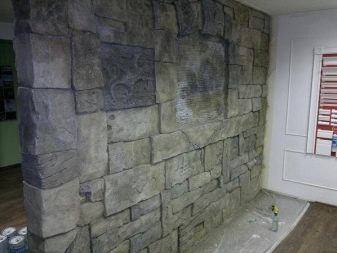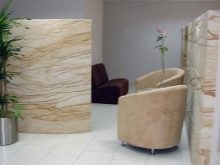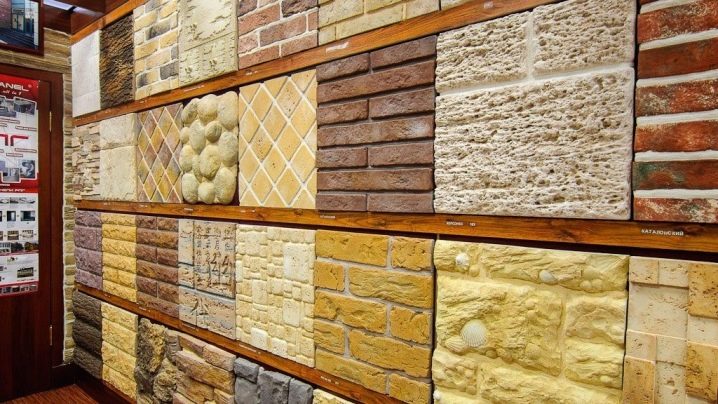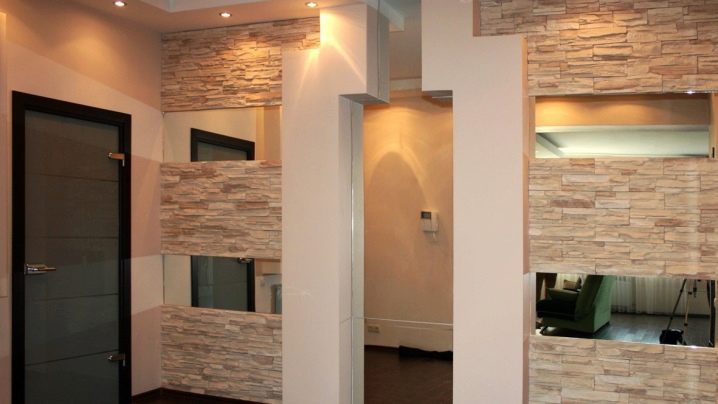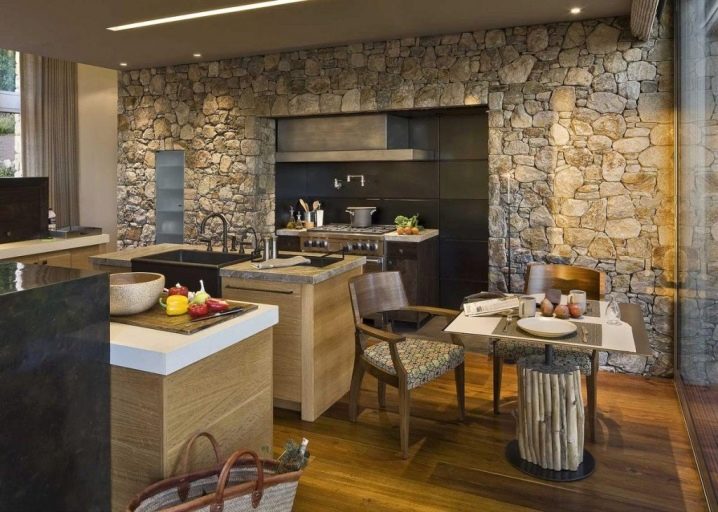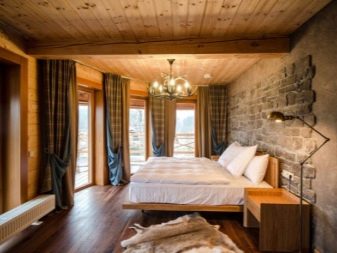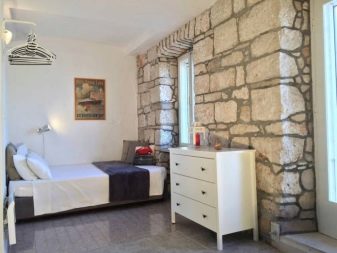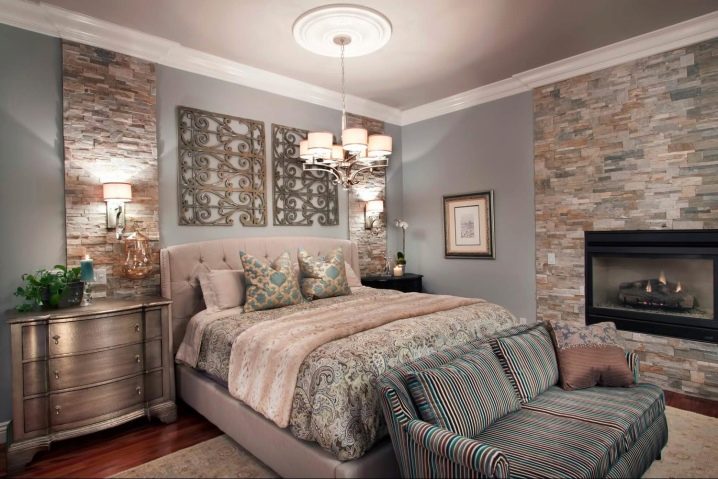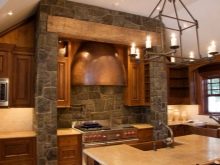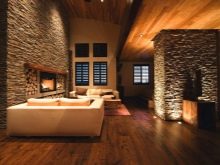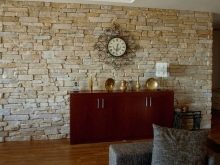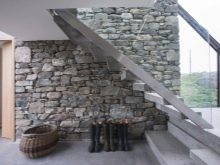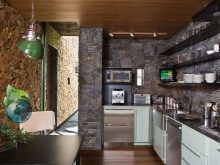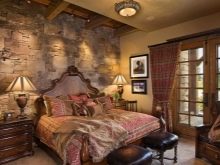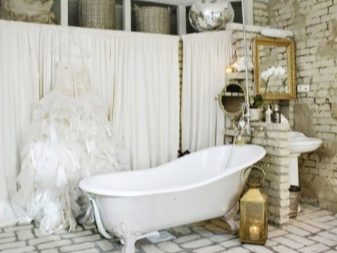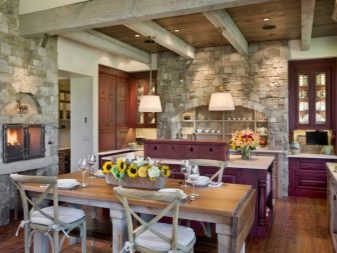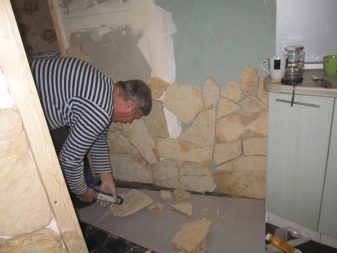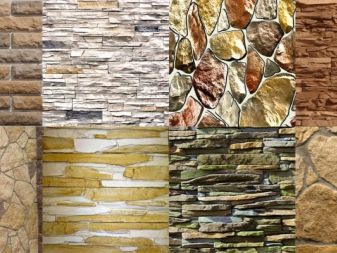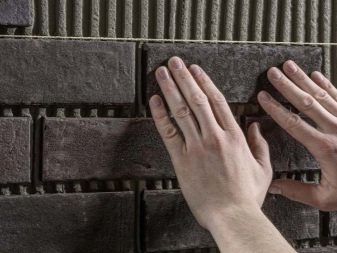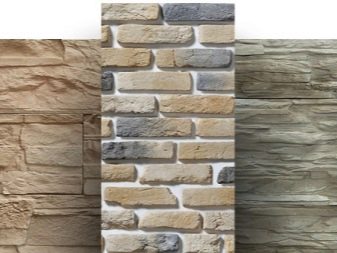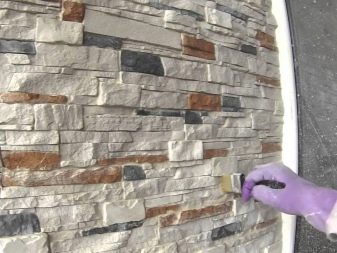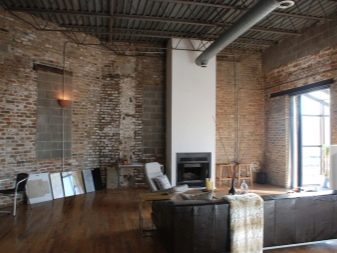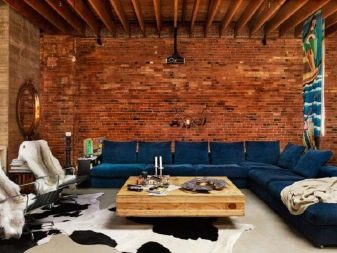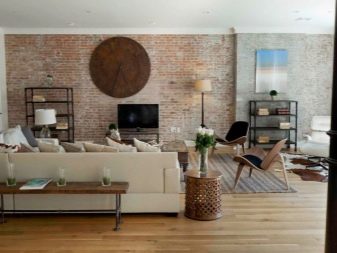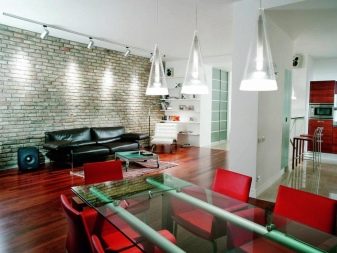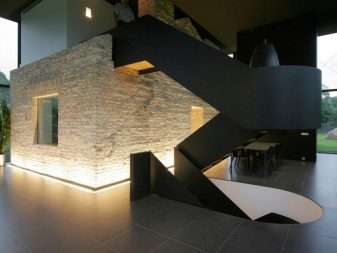Facing stone for interior decoration: variations and design options
Decorative facing stone is a common material for interior decoration. A variety of design options allow you to choose the solution that best fits into the interior and emphasizes its uniqueness.
Application features
The artificial facing stone, unlike natural, is in rather wide demand. Due to its properties, the finishing stone fits perfectly into the interior of the kitchen, hallway. For the interior decoration of the living room, this material is also suitable. Depending on the type of material, you can give the room the spirit of modernity or the Middle Ages, large cities or secluded villages.For example, an imitation of brickwork will be appropriate in a loft style, river pebbles are suitable for creating an interior in Provence or Country style, and a deliberately rough, raw stone will bring a touch of medieval Gothic.
It is not necessary to cover all walls from floor to ceiling with this material.
Combinations of artificial stone and smooth, monochromatic wallpaper - this is a common solution for interior decoration. Simply painted walls will also become a good “neighbor” to this unusual, original material. The masonry itself is quite active, it attracts the eye to itself, so its environment should be more “silent” - only to emphasize the beauty of the stone, but not to over-focus attention on itself. If the stone walls seem too bold decision, but I want to add some brutality to the interior, you can make small elements with artificial stone. A ventilation box, pillars, window or door openings - all this, trimmed with stone, will be a great addition to the basic design.
Advantages and disadvantages
Like any other material, stone for decoration has its advantages and disadvantages. Its main advantage is an affordable price.Of course, when compared with natural elements. This material is light, you can easily use it to decorate the walls of the apartment. Unlike natural stone, artificial does not expose walls to a large load, which means you can not be afraid for their integrity. Besides, artificial stone is very easy to lay, even a beginner can handle it. If the fragments have irregular contours, the task becomes even easier. Here you can do without even the construction level, simply laying out the stones as you want.
Of great importance is the fact that this material is not subject to rotting - neither fungus nor mold appear on it, which means that it can be used even in rooms with high humidity.
Yes, and in the kitchen - the room where food is prepared and where environmental friendliness of the materials used is very important - it can be used without fear. As for the care, this material is quite unpretentious. It is enough to wipe it with a dry or damp cloth. The artificial stone is considered an antistatic material, dust will not accumulate on it, it kind of pushes it away.
The high strength of this finishing material allows it to be used in virtually any room. It is insensitive to mechanical stress and damage.
Chemicals also have no effect on it. It preserves its original appearance for a long time, does not lose its attractiveness, does not wear out and does not tarnish. In the interior of any style artificial stone will be appropriate. A wide variety of shades and textures allows you to choose the best option that will emphasize the characteristics of each particular interior, whether it be country or loft. This is a universal material that can bring a touch of originality to any, even deeply classical interior.
Although, of course, the artificial stone has its disadvantages too. But they are much smaller:
- Cost This criterion applies to both pluses and minuses. Compared with natural material, artificial stone is cheaper. But in itself it is not an economical option for interior design.
- This is a “cold” material, its surface is cold just like with metal, concrete and others.
The advantages of an artificial stone are much greater, for some minuses alter the advantages. Most often this is due to the price.Not everyone can afford to finish the apartment with a stone, even if it is artificial.
Types of material
Before you start decorating the premises with artificial stone, you need to decide on the type of material that will be used. For example, ceramic stone can be used to imitate polished marble slabs. Floor covering, stairs, window sills - in all these cases ceramic stone, made of stoneware, would be appropriate. If you need to create a surface of "torn", uneven stones or brickwork, then suitable clinker tiles. In the manufacture of porcelain stoneware used feldspar, and in the production of clinker - special grades of clay.
The main advantage of these materials is that there are no synthetic binders in their composition. High strength, these materials are obtained by firing at high temperatures.
In addition to ceramic, there are other types of artificial stone:
- Gypsum. This stone is easy to install, it is fire resistant (non-combustible), high and low temperatures have no effect on it.But this kind of artificial stone is not completely moisture resistant. To protect it from moisture, it is enough to cover the stones with a water-repellent coating, for example, with the same varnish. Externally, gypsum stone looks like sandstone.
- Acrylic. This material is moisture-resistant, not amenable to physical or mechanical stress. It differs in simplicity in leaving, after all it can be cleaned with a simple rag, without using any detergents. It is light, non-toxic (does not emit any harmful substances, does not adversely affect a person), fire-resistant, and is able to withstand significant temperature differences.
- Quartz. It is characterized by durability, durability and frost resistance. This material loses its attractiveness even when exposed to bright sunlight, because it is not prone to fading. It can withstand significant loads without deforming. Easy to assemble and handle (can be cut using diamond discs and give any desired shape). When cutting the stone, it is necessary to continuously spray it with water, and also it is necessary to ensure the protection of the respiratory tract from the ingress of stone dust.
- Cement. It consists of sand, cement, coloring pigments, reinforcing additives, plasticizers and various fillers (ceramic chips, pumice stone, granite). It can be mounted on any surface. This type of artificial stone is the most common.
- Flexible stone. This is a relatively new material, which not so long ago appeared on the market, but has already managed to gain popularity. It consists of a textile base and sandstone crumbs or a very thin slice of natural stone, which is applied to the base with the help of polymers. Thus obtained fabric has a low weight, elasticity and flexibility. The material is non-flammable, environmentally friendly and resistant to temperature extremes (from -45 to +150 degrees). It can be mounted on any surface. The moisture-proof, vapor-proof canvas can be used even in rooms with high humidity, for example, in the bathroom or in the kitchen.
The main advantages of artificial stone are inherent in any of its varieties.
Such advantages include high strength and durability, insensitivity to temperature, chemical or mechanical stress, long service life, ease of installation and incombustibility.They differ, for the most part, in appearance and form. And, of course, the price. For example, acrylic decorative stone will cost a little more than the same plaster or cement.
Design examples
Modern interior design is a reasonable combination of price and quality. Cheap materials made of poor plastic and attractive only in terms of price are no longer in fashion. Now demand high-quality, durable, aesthetic and environmentally friendly materials. These include artificial stone. Thinking through the finishing of the house, it is important to choose the right material. It should not only have good technical characteristics, but also fit harmoniously into the interior. In addition, each room has its own requirements for the materials used.
So, when finishing the kitchen, an important role is played by the material’s resistance to high temperatures, the effects of steam (especially if an apron is made of this material), its environmental friendliness and ease of maintenance. The kitchen is a room in which the family spends quite a lot of time where food is cooked, which means that the material used must be harmless and, even at high temperatures, do not emit any hazardous substances.For the dining area will suit the same brickwork of light shades, imitation of river or "wild" stone. The dining area should not stand out from the general style of the kitchen. If the kitchen and dining area are located within the same room, it is important to maintain unity in the design of these two areas.
Making a bedroom requires, in addition to environmental friendliness, calm shades, a feeling of comfort, because it is in this room that a person rests after a hard day.
Here bright, screaming colors, cold surfaces will be inappropriate - everything that causes disharmony. Decorating with decorative stone is a kind of traditional design. She is able to emphasize the status of the owner, his sense of style and recall the traditions. Its natural shades will create a harmonious, cozy atmosphere.
The artificial stone will look good in combination with wood, with forged elements, plaster or wallpaper. The stone wall will benefit from such a "neighborhood". And also will emphasize a stone surface greens. Curly, ampelous plants in beautiful pots will look great against the background of the stone masonry. In the living room, the stone will also look advantageous.Brickwork in white or black will give an industrial touch and is optimally suited for modern styles (loft, minimalism, hi-tech).
The so-called ragged stone will fit well into the style of country or shebbi-chic, if it is processed accordingly. And also it will be appropriate in the Gothic style and similar “medieval” interiors. In the classical style, an artificial stone will look quite advantageous. But you need to use it carefully, otherwise the interior will be overloaded and instead of a cozy apartment you will get a gloomy room in which it is uncomfortable to be.
In order not to be mistaken, it is better to use a stone to decorate certain interior elements, such as window and door openings, arches, columns (an essential attribute of a classic interior), a fireplace and others. You can simply lay out the corners of the stone with a stone, imitating the masonry destroyed by time. It will look good combination of artificial stone with laminate - it will emphasize the classic luxury of the interior, its status.
Mounting technology
The process of installation of artificial stone is quite simple. It can be easily done by hand. Only you need to follow some rules:
- First of all, the walls of the room must be prepared for laying stone. To do this, they remove the old plaster and wallpaper. To level the walls used plaster or sheets of drywall.
- The next step is planning the lighting system and organizing the wiring. This is very important because the stone needs high-quality lighting, which affects the perception of its structure, makes it sparkle, play, emphasizes all its virtues. If you plan to conduct LED backlight, plasterboard is well suited for leveling the walls. The gap between the sheet and the wall makes it possible to install appliances.
- It is possible to mount a stone on a special adhesive, a solution of putty or with the help of liquid nails. Most often when laying stones used glue.
- If the contours of the stones are even, for example, imitation of a brick, then when laying it is better to use the construction level. Then the rows will go smoothly, neatly and beautifully. The use of a level requires certain skills, skills, so this work is best left to professionals.
- When facing corners it is better to use a flexible stone.This elastic material will allow you to accurately arrange the corners of the walls or any structures. Installation of flexible stone is very simple, does not require special skills. Even a novice can easily cope with this task.
- The final stage is the filling of the seams between the stones with a special solution (made when necessary). This will require a quality elastic composition that will last a long time and will not lose either its properties or its original appearance. Most often, the grout is used the same material on which the stones were mounted. If laying was made on glue - rubbed with glue, on cement - with cement.
Tips and tricks
When decorating walls with artificial stone, it is important to choose the right wall decor, which would emphasize the structure and “character” of the stone. The classic combination of stone and wood will look advantageous in any interior, from classic to country. Forged items, greens also successfully underline the texture of the stone. If imitation of brickwork was used for cladding, then it is best to use decor in contrasting colors. For example, if the wall is lined with white brick,it will look good on her low-key picture in a simple black frame.
In general, brickwork is now an element of an industrial style loft.
You can see it in a minimalist interior and in hi-tech style. Therefore, its “neighbors” should be such items that would support this industrial, modern spirit or, on the contrary, sharply contrasted with it. By itself, masonry is an active element of the interior. Therefore, it is not necessary to surround it with too bright decor. He should emphasize unusual material finishes, and not distract attention from him.
Detailed instructions for laying artificial stone, see the video below.
